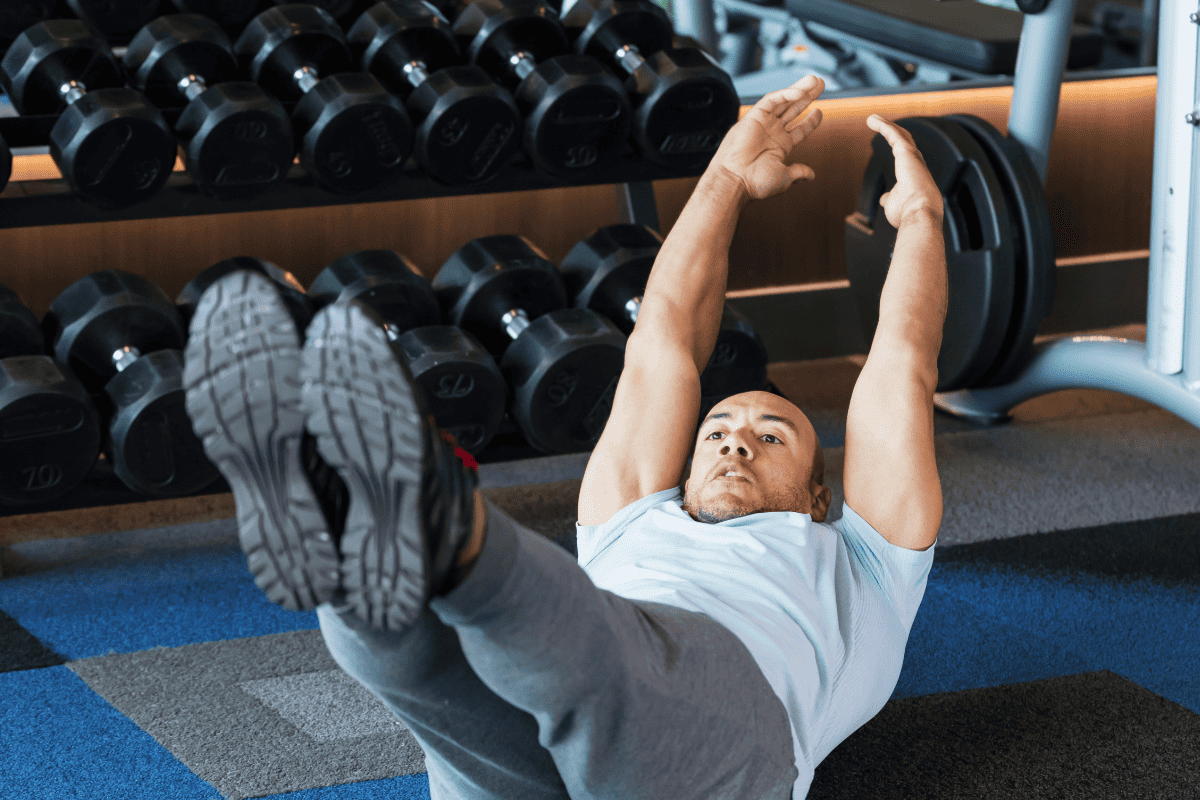11 Best V-Up Alternatives for Core Strength & Stability
You may already be familiar with V-Ups—a great exercise for targeting your core and sculpting your abs.
But like with any exercise, continuous repetition of the same movement can lead to staleness, diminished interest, and potentially plateaued results. That’s why exploring alternative exercises is crucial to keeping your workouts fresh, engaging, and effective.
In this article, I’ll delve into a series of V-Up alternatives that can add variety to your workout regimen and keep your muscles guessing. These alternatives will not only challenge your abs from different angles but will also incorporate other muscle groups, providing a well-rounded and dynamic workout experience.
This article contains affiliate links. If you buy something using these links I may earn a commission.
V-Up Alternative Exercises
I’ve tried to include as much variety in this list of V-Up alternatives as possible.
Whether you’re looking to diversify your routine, accommodate a physical limitation, or you’re simply in search of a new challenge, there’s bound to be a V-Up alternative listed below that suits your needs.
Suitcase Crunches
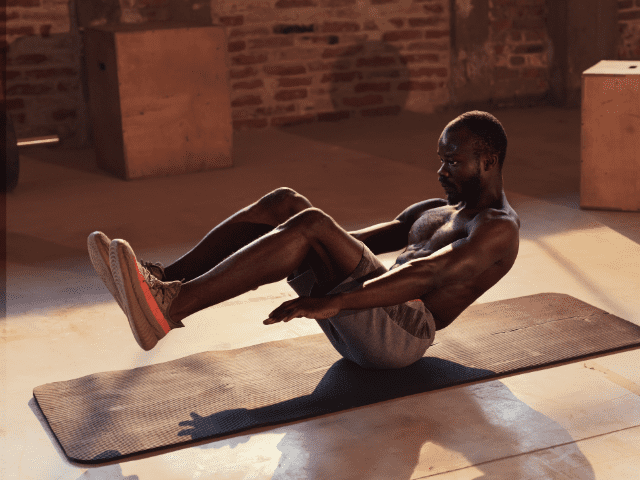
A Suitcase Crunch is almost the exact same movement as a V-Up, but with knees bent instead of straight.
Having the knees bent makes the movement a little easier, so if you’re struggling with V-Ups, Suitcase Crunches can be a perfect V-Up alternative.
Step-by-Step Instructions
- Start by sitting on the ground, balancing on your butt with legs and back up off the ground.
- Legs should be almost straight, feet roughly six inches off the ground. Torso should be leaned back at about a 30-degree angle.
- From the starting position, crunch up, bringing the knees and chest together above the hips (like a suitcase shutting)
- Lower back to the starting position and repeat until all reps are completed. (Feet and back should stay off the ground throughout the movement)
Coaching Points
If you keep your feet uncrossed during the movement, your groin will be forced to stay engaged. This creates a small added bonus to the exercise.
Bicycle Crunches
Bicycle Crunches are another more beginner-friendly alternative to V-Ups.
They will also challenge both your lower abdominals and your hip flexors, but also more heavily incorporate the obliques.
How To
- Lay on your back with your knee and hip flexed to 90 degrees
- Raise your shoulder blades off of the ground several inches and put your hands behind your head.
- Keep your chin off of your chest and keep your left leg off of the ground.
- Straighten your right knee while simultaneously driving the left knee in the opposite direction toward your shoulder.
- Touch your left knee to your right elbow and immediately repeat to the other side.
- Each time your right elbow touches your knee left knee, count as one repetition.
Coaching Points
Your hands behind your head should only be there for support. Do not pull on your head.
Russian Twists
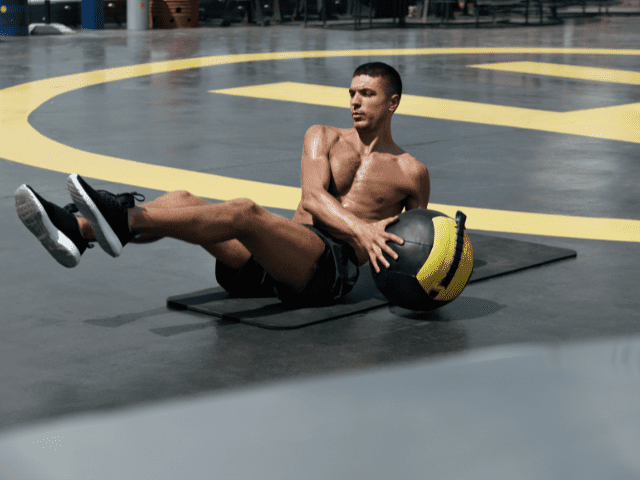
Russian Twists are another core movement that heavily involves the hip flexors because the feet have to be held off the ground during the movement.
Like Bicycle Crunches, Russian Twists also incorporate the obliques more into the movement than V-Ups.
Step-by-Step Instructions
- Start by taking a seat on the floor and clasping your hands together (can also be done holding a medicine ball as shown above).
- Slightly bend the knees and raise your feet roughly six inches off the floor.
- Start by rotating your torso to the left, taking your right elbow toward your left knee.
- Now turn your shoulders and rotate your torso to the right, now taking your left elbow toward your right knee.
- Keep legs mostly still and maintain the feet off the floor throughout the movement.
- Continue rotating back and forth until all reps are completed.
Coaching Points (Common Mistakes)
The biggest mistake I see with athletes when doing Seated Twists is moving their hands back and forth instead of rotating through the core. The focus should be on the rotation. What the hands and arms do is merely a product of rotating through the torso.
Planks

Planks are a compelling alternative to V-Ups as they provide a full-body workout that engages multiple muscle groups beyond the abs, including the shoulders, back, and glutes.
Planks can also be a safer option for individuals with lower back issues. They’re also easy to modify based on the experience and core strength of the individual.
Step-by-Step Instructions
- Start on the ground on your stomach.
- Assume a push-up like position on your elbows and toes. Elbows should be directly under the shoulders.
- Position your body in a straight line from the shoulders through the hips, knees and ankles.
- Brace the core tight. (As if you’re going to be punched in the stomach)
- Do not let the body slouch to the ground nor push the hips up high in the air.
- Hold for the designated amount of time.
Coaching Points
The biggest mistake that I see with Front Planks is athletes holding the position, but not properly keeping the core engaged and just allowing the torso to slouch. So, while they are technically up on their elbows and toes, all they’re really doing is straining the low back.
The other mistake I see is the exact opposite and that is athletes shooting their butts into the air, resembling more of a Down Dog position.
The difference between the two is the second, having your butt too high, is easier to notice and corrected more often. However, letting the body slouch during a plank is often allowed to pass as ‘good form’ when it is not.
Hollow Rock
Hollow Rocks are an excellent V-Up alternative as they engage the entire core, demanding stability and control from the abs and lower back. Their rhythmic motion also enhances neuromuscular coordination and body awareness.
Plus, they can be done with little to no equipment, making them an accessible exercise for any setting.
How To
- Lay on your back, legs straight and arms extended overhead.
- Brace the core and lift the feet roughly six inches off the ground.
- Now, slowly rock up and down, a few inches in each direction.
- Focus on keeping core tension throughout the movement.
Coaching Points
You don’t need to go crazy with how much you rock. Keep the rock small and controlled (arms and feet shouldn’t hit the ground) and focus on maintaining core tension.
Straight Leg Raises
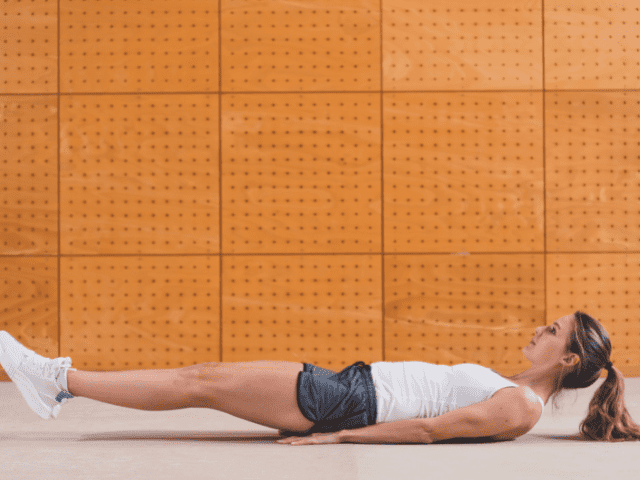
Straight Leg Lifts offer a potent alternative to V-Ups by directly targeting the lower abdominal muscles, the same area of focus of V-Ups.
They can also help improve hip flexor strength while also enhancing lower back strength and stability.
Step-by-Step Instructions
- Lay on your back, feet together, legs straight.
- Arms can either be at your side or underneath your low back as support*.
- Start by raising the feet to six inches off the floor.
- Now, using the core, raise the feet until they are straight up (perpendicular to the floor**)
- Finally, lower the legs under control back to the starting position – feet six inches from the floor.
- Repeat for the designated number of reps.
Coaching Points
*Some will find that Straight Leg Leg Raises puts an uncomfortable strain on the low back. Placing both hands under the low back will alleviate this strain for most. If you still find the exercise uncomfortable then I suggest trying one of the alternatives below.
**If you find yourself struggling with being able to get your legs perpendicular to the floor while keeping them straight, then I would highly suggest working on your hamstring flexibility. You should be able to achieve at least this level of range of motion.
Don’t rush through the movement. The eccentric portion of the movement (lowering the legs) is just as effective at working the abs as the concentric portion.
Hanging Straight Leg Raises
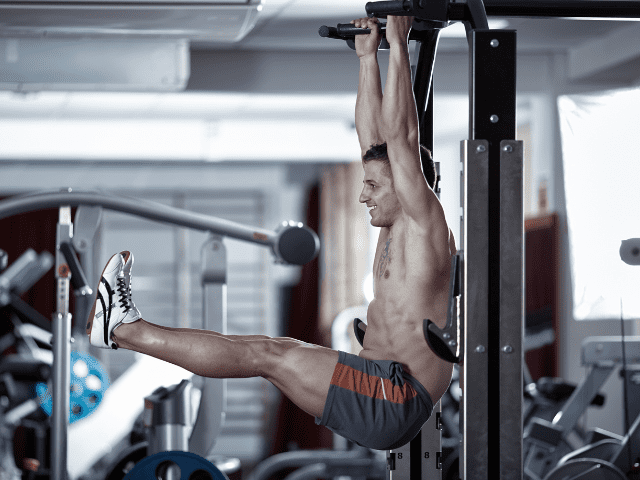
Hanging Straight Leg Raises are a beneficial alternative to V-Ups as they intensify the abdominal work by using gravity as resistance and fully engaging the hip flexors.
Additionally, they can be a challenging exercise to the arms, shoulders, and grip, improving overall upper body strength.
Step-by-Step Instructions
- Find yourself a pull-up bar and grip the bar with an overhand grip.
- Engage your lats so your body doesn’t go limp once you begin to hang.
- Now hang from the bar and keeping your legs straight, drive them up to hip height (or slightly above hip height).
- Finally, actively lower your legs back to the starting position – don’t allow the legs to just swing down.
- Repeat until all reps are completed.
Coaching Points
The biggest issue that most of my athletes run into when doing Hanging Straight Leg Raises (or any hanging ab exercise for that matter) is how to keep from swinging out of control.
To keep from swinging, you have to actively lower your legs back down. If you ‘let your legs go’ and just allow gravity to take over you’ll completely lose control of the movement. Timing and rhythm are also both important for Leg Raises and you can’t achieve either if you’re not in control of your legs throughout the movement.
Mountain Climbers
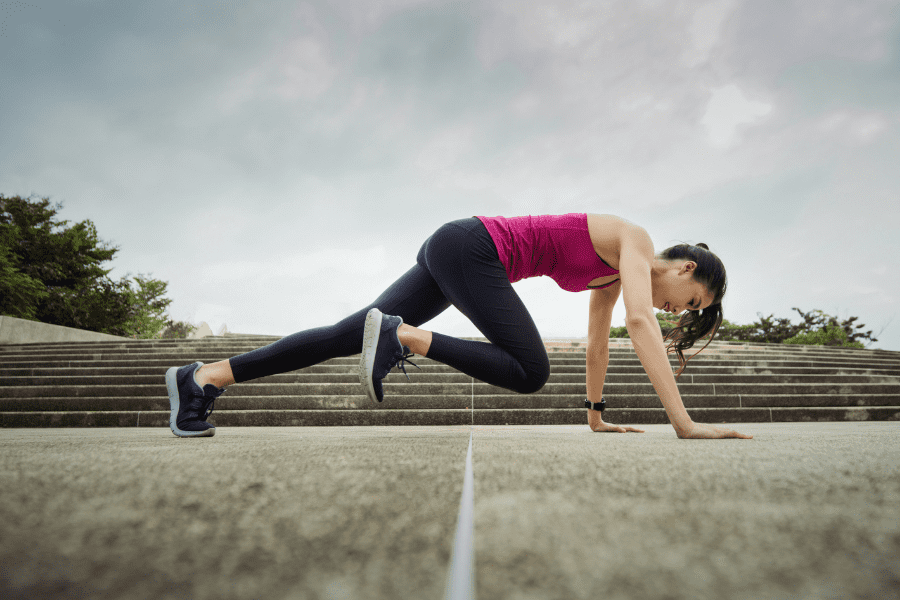
Mountain Climbers are a great alternative to V-Ups because they not only work the core but they can also deliver a high-intensity cardio workout, boosting overall fitness and calorie burn.
Step-by-Step Instructions
- Begin in a push-up position – hands under shoulders, core engaged, body in a straight line
- Now raise one knee toward the chest and place the ball of the foot on the ground – from this position you’re ready to begin performing reps.
- Drive one leg up and place the foot right next to where the opposite foot just left.
- Simultaneously extend the ‘up foot’ back to the original starting position.
- Continue alternating back and forth until all reps are completed. (count moving left and right legs up as one rep)
Coaching Points
There are a few common mistakes that athletes make when doing Mountain Climbers – especially if they are fatigued.
- Keep hips down throughout the movement. Don’t allow the hips to start to raise as the legs get tired.
- Keep driving the knees straight up toward the chest. Tired athletes will tend to start turning their feet and knees out to the side.
- Finally, try to maintain the same distance of each rep. Range of motion is usually the first thing to go when fatigue sets in.
Boat Pose (Navasana in Yoga)

Boat Pose, or V-Up Holds, is a yoga pose that is essentially a static hold of the top of the V-Up movement.
Step-by-Step Instructions
- Sit on the floor with your legs extended in front of you. Your back should be straight, and your arms should be at your sides.
- Gently bend your knees and place your feet flat on the floor. Keep your legs together.
- Inhale deeply and as you exhale, lean back slightly while keeping your back straight. Engage your core muscles to maintain balance.
- Start to lift your feet off the floor. Keep your thighs close to your abdomen, and your shins parallel to the floor. This is the “half boat pose.”
- If it’s comfortable for you, extend your legs so that they are at a 45-degree angle to the floor. Your body will now make a ‘V’ shape, and because of this, it’s also known as the V Pose.
- Extend your arms straight out in front of you, parallel to the floor. They should align with your shoulders with your palms facing each other.
- Try to balance on your sit bones, not leaning too far back. Gaze at your toes and try to keep your chest lifted and your spine straight. Hold this pose for about five breaths or longer if comfortable.
- To come out of the pose, lower your legs and hands as you exhale. You can bend your knees and place your feet on the floor if needed.
Coaching Points
Use Props for Assistance
Props can be extremely helpful, especially for beginners or those with less core strength. A yoga block placed behind the sacrum (the lower back) can provide support and stability, allowing the practitioner to get a feel for the pose without straining.
Additionally, using a yoga strap around the soles of the feet can help maintain leg extension if someone has tight hamstrings.
Prioritize Form Over Depth
A common mistake is trying to fully extend the legs at the expense of rounding the back, which can put strain on the spine. It’s more important to keep the spine straight and the chest lifted, even if that means the legs aren’t fully extended.
Similarly, if someone is struggling to balance, it’s better to keep the toes touching the ground or the knees bent until strength and balance improve.
Reverse Crunches
Reverse Crunches are an excellent alternative to V-Ups because they specifically target the lower abs, similarly to how V-Ups do.
How To
- Start laying on your back with hands either out to the side or under the low back for support.
- Lift the legs up six inches off the ground.
- Pull the knees in toward the core.
- Now, extend the legs and drive the feet straight up in the air – lifting the hips up off the ground.
- Retrace back to the starting position (keep feet off the ground) and repeat.
Coaching Points
Focus on using the core to really lift the hips off the ground and drive the legs into the air at the top. Then, move more slowly and under control back to the start.
Flutter Kicks
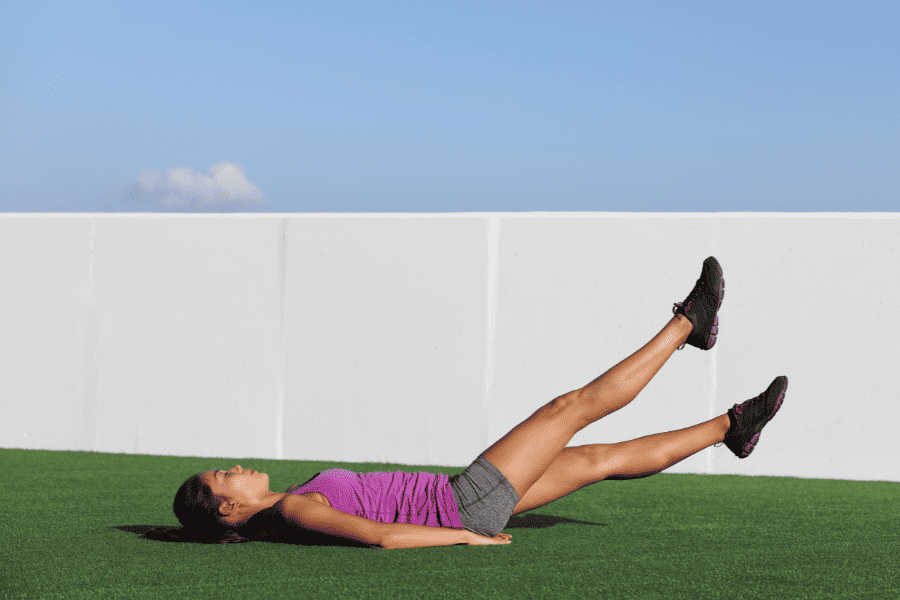
Flutter Kicks serve as a solid V-Up alternative by primarily targeting the lower abdominal muscles, a key area for total core strength. They also work the hip flexors and quads, just like V-Ups do.
However, while V-Ups are extremely challenging, even for experienced athletes, Flutter Kicks are perhaps the most beginner-friendly movement out of the all core exercises in this list.
Step-by-Step Instructions
- Lie flat on your back on a mat or the floor, with your arms at your sides and your palms facing down.
- Engage your core muscles and keep your back in a neutral position.
- Raise your legs off the ground about 6 to 8 inches, keeping them straight and together. This is your starting position.
- Begin the fluttering motion by rapidly alternating small up-and-down movements with your legs, keeping them straight and together.
- Make sure you are using your abdominal muscles to control the movement, and avoid arching your back or lifting your shoulders off the ground.
- Continue alternating your legs until all reps are completed.
Coaching Points
If you find that Flutter Kicks strain your low back, you can use your hands or a rolled up towel to place under your low back for support.
Flutter kicks can be done anywhere, without any equipment, making them a convenient and accessible exercise. They can also be modified to suit different levels of experience, making them a versatile exercise for people of all abilities.
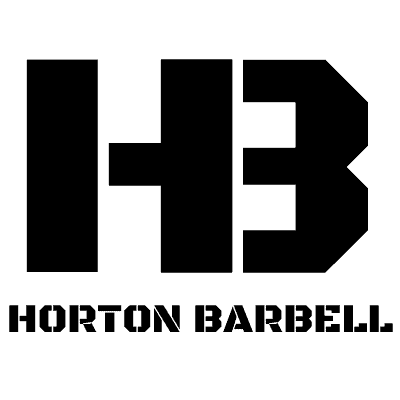
Online Strength Programs
- 1-on-1 Online Coaching
- Sports Performance Programs for Football, Basketball, Soccer & More
- Programs for Former Athletes (Legends) Who Still Want to Train Like Athletes
- Programs for Adults Who Want to Get Healthy (and look great at the beach!)
- Use Code “HB10” to Get 10% Off Today
Final Thoughts
Each of the V-Up alternatives listed above offers a unique way to challenge your core and can help keep your workouts exciting. Don’t be afraid to experiment and integrate some (or all!) of these options into your strength program.
Whether you’re seeking to target slightly different muscle groups, accommodate specific physical needs, or just craving a change in your routine, there’s a V-Up alternative out there waiting for you.
Here’s to a stronger, more resilient, and well-rounded core!

